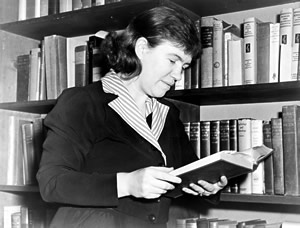 We tend to think that rapid change is something that is only affecting us today. Actually, in different parts of the world, it has been going on for many years. One of the greatest students of change and how people adapt to it was the anthropologist Margaret Mead.
We tend to think that rapid change is something that is only affecting us today. Actually, in different parts of the world, it has been going on for many years. One of the greatest students of change and how people adapt to it was the anthropologist Margaret Mead.
Mead, who lived from 1901 to 1978, made huge contributions to our understanding of human life and society. Most historians credit her as being one of a handful of people who developed the methods of modern anthropology. She lived with and studied the tribes of New Guinea, where she saw an entire society transformed in a matter of years from the stone age to the modern age, thanks to the impact of World War II. She drew important conclusions about how people and society respond to such rapid change, and shared the lessons throughout the world.
“Nesting in the gale”
Mead was fond of colorful stories and analogies to explain the behaviors of the subjects she studied, both human and animal. She was particularly fond of cliff-dwelling swallows, which in her opinion offered a lesson to parents seeking to bring up children who would have the necessary skills to survive and thrive in the world.
She wanted all people to learn how to bring up children who could “nest in the gale.” Asked what this meant, she said that it had to do with “being able to be at home anywhere in the world, in any house, in any time band, eating any different kind of food, learning new languages as needed, never afraid of the new, sad to leave anywhere where one has been at home for a few days, but glad to go forward”
She went on to explain that these swallows that build their nests high on the rocky cliffs which overlook the Pacific Ocean. Even in gale force winds these birds build their nests and raise their young. They also display a strong sense of community, helping each other to find food in these harsh conditions and migrating in large flocks. Mead concluded: If we teach our children to put down deep roots and firm foundations they will not only survive, but will also thrive in a world marked by accelerating change.
To draw my own analogy from Mead’s colorful story of the cliff-dwelling swallows, if we have strong roots, that enables us to have strong wings – which we can utilize to bravely explore, adapt to and be successful in our fascinating world.
What does this mean to us today?
Today’s world is marked by a rate of change that even Mead couldn’t have anticipated. That makes it even more important for us to be adaptable. The “gales” we face today may include:
- Changing technology, which can transform entire industries in a matter of a few years
- A lack of job security,
- Ambiguity (not enough of the right information to do our jobs effectively),
- Information overload (we’re buried under too much of the wrong information),
- Workplace expectations regarding work/life balance (or lack thereof)
We can also learn from the way in which Mead analyzed her research. The Facts on File website summarizes what made her unique in this way:
“Mead’s genius was not so much for digging deeply into one limited subject of scientific inquiry as it was for seeing connections and relationships. She could take in huge quantities of new information from many different sources and pull all of it together into a fresh point of view, then communicate her insights clearly to a large audience. She always wanted the things she learned to change human life for the better.”
This describes exactly what we need to be able to do in order to add value to our work: To be able to look at the same information as everyone else, and see patterns and relationships that others can’t. But that’s only half of the equation: We must also be able to communicate our insights with great clarity and persuasive power. And we must seek the good of all as we develop and present our ideas.
As I talk about throughout Up Your Impact, we are living in a time of accelerating change. We cannot expect our world to sit still for us. To the best of our ability, we need to try to understand and embrace change, despite the discontinuities it tends to cause. We, too, must be adept at nesting in the gale. In other words, we cannot regard change and something that is dreaded and feared, but rather a normal part of our environment, to which we must adapt on an ongoing basis.

"Mead, who lived from 1901 to 1978, made huge contributions to our understanding of human life and society…"
"Mead’s genius was not so much for digging deeply into one limited subject of scientific inquiry as it was for seeing connections and relationships."
It could be worth mentioning, that in light of later anthropological research, much of Margaret Meads research, information and analysis concerning societies on New Guinea and Samoa has been shown to contain both severe factual errors and gross misrepresentation of reality that borders on fraud.
Se for example Derek Freeman, "Margaret Mead and Samoa: The Making and unmaking of an anthropological myth", 1983, Harvard University Press, Cambridge, Mass.